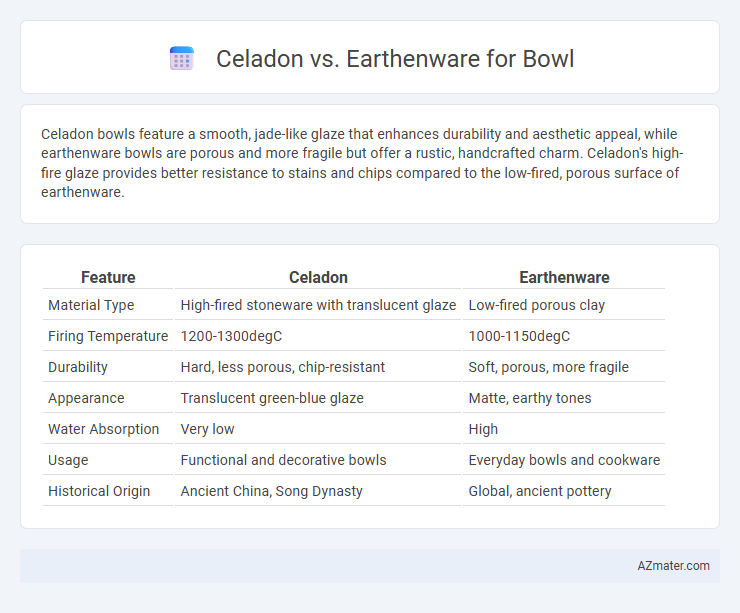Celadon bowls feature a smooth, jade-like glaze that enhances durability and aesthetic appeal, while earthenware bowls are porous and more fragile but offer a rustic, handcrafted charm. Celadon's high-fire glaze provides better resistance to stains and chips compared to the low-fired, porous surface of earthenware.
Table of Comparison
| Feature | Celadon | Earthenware |
|---|---|---|
| Material Type | High-fired stoneware with translucent glaze | Low-fired porous clay |
| Firing Temperature | 1200-1300degC | 1000-1150degC |
| Durability | Hard, less porous, chip-resistant | Soft, porous, more fragile |
| Appearance | Translucent green-blue glaze | Matte, earthy tones |
| Water Absorption | Very low | High |
| Usage | Functional and decorative bowls | Everyday bowls and cookware |
| Historical Origin | Ancient China, Song Dynasty | Global, ancient pottery |
Introduction to Celadon and Earthenware
Celadon is a type of ceramic known for its distinctive translucent glaze, typically pale green or blue, created through a high-temperature firing process that produces a smooth and glassy surface. Earthenware, in contrast, is made from porous clay fired at lower temperatures, resulting in a more opaque and rustic finish commonly found in everyday bowls and cookware. Both materials differ significantly in durability, aesthetic appeal, and water resistance, impacting their functional and decorative uses.
Historical Origins of Celadon and Earthenware
Celadon originated in ancient China during the Eastern Han Dynasty, renowned for its jade-like glaze achieved through iron oxide firing techniques, while earthenware dates back to prehistoric times globally, characterized by its porous, unglazed or low-fired ceramic nature. Celadon's distinct greenish-blue glaze was highly prized in East Asia, spreading through trade routes such as the Silk Road, contrasting with the widespread, utilitarian use of earthenware in everyday pottery across various cultures. The technological and aesthetic advances of celadon represented a significant evolution from the simpler, more rudimentary earthenware typically used for domestic bowls and vessels.
Material Composition and Firing Techniques
Celadon bowls are crafted from a refined stoneware clay mixed with iron oxide, which produces their signature translucent, jade-green glaze through high-temperature oxidation firing around 1250degC. Earthenware bowls consist of a more porous, coarser clay body fired at lower temperatures, typically between 1000degC and 1150degC, resulting in a more porous and less durable finish often glazed to improve water resistance. The high firing of celadon enhances vitrification and strength, while earthenware's low firing preserves its rustic texture but requires sealing to prevent absorption.
Visual Appeal: Glaze and Color Differences
Celadon bowls feature a translucent, pale green glaze that highlights intricate surface details and creates a smooth, glossy finish, enhancing their visual appeal with subtle depth and elegance. Earthenware bowls typically have a more opaque glaze with richer, earth-toned colors such as warm reds, browns, and ochres, offering rustic charm and a tactile, matte or satin finish. The color variations in celadon arise from iron oxide in the glaze fired in a reduction atmosphere, while earthenware glazes rely on varying mineral oxides fired in oxidation, resulting in distinct aesthetic textures and hues.
Durability and Strength Comparison
Celadon bowls exhibit higher durability and strength compared to earthenware due to their vitrified, stoneware-like composition and firing temperature around 1200degC to 1300degC, which creates a dense, non-porous structure resistant to chipping and cracking. Earthenware bowls, fired at lower temperatures between 1000degC and 1150degC, remain more porous and fragile, making them susceptible to breakage and water absorption over time. The superior hardness and toughness of celadon make it ideal for everyday use, whereas earthenware's delicate nature suits decorative purposes.
Functionality for Everyday Use
Celadon bowls offer superior durability and chip resistance compared to traditional earthenware, making them ideal for everyday use in both microwave and dishwasher settings. Earthenware, while aesthetically warm with its porous structure, requires more careful handling due to its higher fragility and tendency to absorb liquids. The non-porous glaze of celadon ensures easier cleaning and prevents stains, enhancing functionality for daily kitchen tasks.
Maintenance and Care Requirements
Celadon bowls require gentle cleaning with mild soap and avoid abrasive scrubbers to preserve their translucent glaze and prevent surface damage. Earthenware bowls are more porous, demanding thorough drying to prevent moisture absorption and potential cracking, and should be hand-washed rather than placed in a dishwasher. Both materials benefit from careful handling to maintain their aesthetic appeal and durability over time.
Cultural Significance and Symbolism
Celadon bowls, renowned for their jade-like glaze, hold deep cultural significance in East Asia as symbols of purity, elegance, and status, often associated with refined ceremonies and royal use. Earthenware bowls, rooted in various folk traditions worldwide, embody earthiness and authenticity, symbolizing daily life, sustenance, and communal bonding. The contrasting symbolism highlights celadon's link to spiritual and aesthetic ideals, while earthenware emphasizes practicality and connection to the natural world.
Pricing and Market Availability
Celadon bowls typically command higher prices due to their intricate glazing process and historical prestige, often ranging from $30 to $150 depending on craftsmanship and origin. Earthenware bowls are generally more affordable, usually priced between $10 and $50, reflecting their simpler production techniques and widespread availability. Market availability favors earthenware, with mass production ensuring easy access in most retail and online stores, while authentic celadon is more commonly found in specialty shops and artisan markets.
Choosing the Right Bowl: Celadon or Earthenware
Choosing the right bowl depends on the desired aesthetic and functionality, where celadon offers a translucent glaze with subtle blue-green tones that enhance delicate presentations, while earthenware provides a rustic, porous texture ideal for everyday use and heat retention. Celadon bowls are typically fired at higher temperatures, making them more durable and chip-resistant compared to the lower-fired, more fragile earthenware bowls. Understanding the differences in glazing, durability, and cultural significance helps select the perfect bowl tailored to both artistic preference and practical needs.

Infographic: Celadon vs Earthenware for Bowl
 azmater.com
azmater.com